by Nancy Kalajian, photos by Kayte Deioma
 The Peabody Essex Museum, in Salem, MA, is a gem. Located north of Boston, it has been recently transformed into a splendid showcase featuring exceptional artistic and cultural collections from Asia, Asia Export, and Africa, as well as Native American, American, Oceanic, Maritime, and Photography exhibits. The museum is sprawling, and contains parks, gardens and 24 historic properties.
The Peabody Essex Museum, in Salem, MA, is a gem. Located north of Boston, it has been recently transformed into a splendid showcase featuring exceptional artistic and cultural collections from Asia, Asia Export, and Africa, as well as Native American, American, Oceanic, Maritime, and Photography exhibits. The museum is sprawling, and contains parks, gardens and 24 historic properties.
 Entering the spacious, glass-filled, atrium main lobby can somewhat brighten an otherwise dreary day. The museum’s displays, descriptions/interpretations, and lighting are quite up to date, and most inviting to visitors. One very special feature is a 200 year old house from China, the only example of Chinese domestic architecture – from the Late Qing Dynasty – on display in the US. Experiencing this home gives one insight into family life long ago and far away.
Entering the spacious, glass-filled, atrium main lobby can somewhat brighten an otherwise dreary day. The museum’s displays, descriptions/interpretations, and lighting are quite up to date, and most inviting to visitors. One very special feature is a 200 year old house from China, the only example of Chinese domestic architecture – from the Late Qing Dynasty – on display in the US. Experiencing this home gives one insight into family life long ago and far away.
Many traveling exhibitions also visit the Museum. The Kingdom of Siam, The  Art of Central Thailand, 1350 -1800, is on display until October 16, 2005. Eighty treasures from Ayutthaya, a kingdom that flourished for more than 400 years, are displayed in their magnificence. The exhibit includes gold, bronze and stone Buddha images, Hindu sculptures, temple furnishings, jewelry and illustrated manuscripts. These priceless pieces are from collections in Thailand, Europe, and the US.
Art of Central Thailand, 1350 -1800, is on display until October 16, 2005. Eighty treasures from Ayutthaya, a kingdom that flourished for more than 400 years, are displayed in their magnificence. The exhibit includes gold, bronze and stone Buddha images, Hindu sculptures, temple furnishings, jewelry and illustrated manuscripts. These priceless pieces are from collections in Thailand, Europe, and the US.
 There are four rooms to peruse; exhibited items are spaced appropriately so that viewers can give each object ample reflection time. The short film shown in the back of the first room in periodic intervals serves as a good introduction to the exhibit. Curators lead guests to Thailand to view ruins of Ayutthaya, and bring understanding of this religious, architectural, diplomatic and trading center
There are four rooms to peruse; exhibited items are spaced appropriately so that viewers can give each object ample reflection time. The short film shown in the back of the first room in periodic intervals serves as a good introduction to the exhibit. Curators lead guests to Thailand to view ruins of Ayutthaya, and bring understanding of this religious, architectural, diplomatic and trading center
The third room in the exhibit has a very comfortable section with couches  and informative reading materials – in case you need to rest and contemplate the majestic exhibit. The last room centers on architecture, temples and furnishings. The miniature temple buildings are fascinating. On a nearby wall is a large fragment from a full-size temple’s gable decoration with Vishnu, a Hindu deity, mounted on Garuda, the manbird, being surrounded by numerous demonic figures. Mother-of-pearl inlay, seen in a door and cabinet, attest to the high artistic achievement from this period. The catalog, prepared for this exhibit, is remarkable.
and informative reading materials – in case you need to rest and contemplate the majestic exhibit. The last room centers on architecture, temples and furnishings. The miniature temple buildings are fascinating. On a nearby wall is a large fragment from a full-size temple’s gable decoration with Vishnu, a Hindu deity, mounted on Garuda, the manbird, being surrounded by numerous demonic figures. Mother-of-pearl inlay, seen in a door and cabinet, attest to the high artistic achievement from this period. The catalog, prepared for this exhibit, is remarkable.
Make sure to put the Peabody Essex Museum on your to-do list.
For more information, including hours and directions from Boston, visit www.pem.org or call toll free (866) 745-1876.
The Peabody Essex Museum is included in the Go Boston Card.

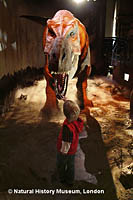 A couple of years ago, the Government decided that everyone should be able to take advantage of the wonderful museums that London has to offer; it made them all free. As a result, they are now more crowded, but as tourists, you won’t have the added expense of entry fees. My family particularly enjoys the Natural History Museum. As with all large museums, it’s best to pick a couple exhibits to see, other wise everyone is overwhelmed and the kids especially have a bad time.
A couple of years ago, the Government decided that everyone should be able to take advantage of the wonderful museums that London has to offer; it made them all free. As a result, they are now more crowded, but as tourists, you won’t have the added expense of entry fees. My family particularly enjoys the Natural History Museum. As with all large museums, it’s best to pick a couple exhibits to see, other wise everyone is overwhelmed and the kids especially have a bad time.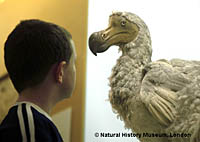 The Life Sciences section has huge fossils and dinosaur skeletons and a special exhibit in which they have a life-sized T-Rex which moves and roars. It’s a bit scary for very little children, so be warned. Other treats are rare stuffed birds, including a dodo. There are wonderful small and large fossils found along the southwest coast (named the Jurassic Coast) of England. The exhibit on Creepy Crawlies attracts kids of all ages back again and again.
The Life Sciences section has huge fossils and dinosaur skeletons and a special exhibit in which they have a life-sized T-Rex which moves and roars. It’s a bit scary for very little children, so be warned. Other treats are rare stuffed birds, including a dodo. There are wonderful small and large fossils found along the southwest coast (named the Jurassic Coast) of England. The exhibit on Creepy Crawlies attracts kids of all ages back again and again.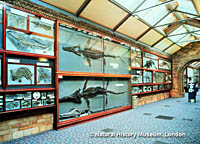 Our favorites are probably the fossils and dinosaurs and the area with the dioramas of prehistoric and modern animals. The huge fossils of prehistoric sea animals displayed on the walls are truly impressive. The smaller ones in the cases inspired us to go to Dorset and the Jurassic coast to look for more -which we indeed found!
Our favorites are probably the fossils and dinosaurs and the area with the dioramas of prehistoric and modern animals. The huge fossils of prehistoric sea animals displayed on the walls are truly impressive. The smaller ones in the cases inspired us to go to Dorset and the Jurassic coast to look for more -which we indeed found!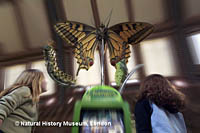 The Earth Sciences exhibits are reached up a long escalator in the main entry hall. You enter through a gallery of rare crystals in cases which are lit with black light to enhance the color
The Earth Sciences exhibits are reached up a long escalator in the main entry hall. You enter through a gallery of rare crystals in cases which are lit with black light to enhance the color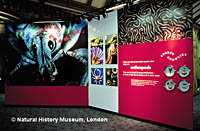 There is also a room fitted out as a small grocery shop in Kobe. Every couple of minutes, there is a recreation of what it would have been like to have been in the shop at the moment of the earthquake – initial tremours, then stronger and stronger shaking.
There is also a room fitted out as a small grocery shop in Kobe. Every couple of minutes, there is a recreation of what it would have been like to have been in the shop at the moment of the earthquake – initial tremours, then stronger and stronger shaking.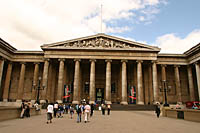 French, American and English teams have done most of the archaeological excavation in Egypt. They each brought home a wealth of treasures which found homes in the Louvre, the Metropolitan Museum of Art and the British Museum. Despite a fascination with ancient Egypt, it was not the mummies that brought me to the British Museum. It was the Celts and the Anglo Saxons. You won’t find many of their ancient arts at the Louvre or the Met. The Brits keep their ancestral artifacts close to home. This is why, despite my penchant for less common pursuits on a rainy day, I happily joined the crowds of school children and tourists descending on the British Museum. I wanted to see what the Celtic half of my ancestors had been up to a couple millennia ago.
French, American and English teams have done most of the archaeological excavation in Egypt. They each brought home a wealth of treasures which found homes in the Louvre, the Metropolitan Museum of Art and the British Museum. Despite a fascination with ancient Egypt, it was not the mummies that brought me to the British Museum. It was the Celts and the Anglo Saxons. You won’t find many of their ancient arts at the Louvre or the Met. The Brits keep their ancestral artifacts close to home. This is why, despite my penchant for less common pursuits on a rainy day, I happily joined the crowds of school children and tourists descending on the British Museum. I wanted to see what the Celtic half of my ancestors had been up to a couple millennia ago.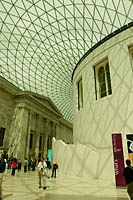 The building which houses the British Museum has gone through a variety of incarnations. The main entrance is through the Greek Revival South Front. This is part of a quadrangle of buildings completed in the mid-1850’s. After this expansion, they were still short of space, so they built a glass dome over the courtyard with the circular Reading Room at its center. It’s a unique space with the colonnades of the old buildings now making up the interior walls of the Great Court, surrounding the multi-level Reading Room.
The building which houses the British Museum has gone through a variety of incarnations. The main entrance is through the Greek Revival South Front. This is part of a quadrangle of buildings completed in the mid-1850’s. After this expansion, they were still short of space, so they built a glass dome over the courtyard with the circular Reading Room at its center. It’s a unique space with the colonnades of the old buildings now making up the interior walls of the Great Court, surrounding the multi-level Reading Room.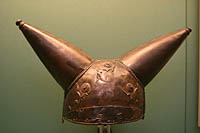 dredged up from the Thames and other river beds in Great Britain, where they had been deliberately deposited over a millennium in some form of water ritual. A circular bronze shield from 1200 to 1000 BC was found in the River Thames in London. The Chertsey Shield from 400-200 BC was dug up from a channel of the Thames in Surrey in 1985. A horned Iron-Age helmet from 150-50 BC, also found in the Thames, is the only one of its kind found anywhere in Europe.
dredged up from the Thames and other river beds in Great Britain, where they had been deliberately deposited over a millennium in some form of water ritual. A circular bronze shield from 1200 to 1000 BC was found in the River Thames in London. The Chertsey Shield from 400-200 BC was dug up from a channel of the Thames in Surrey in 1985. A horned Iron-Age helmet from 150-50 BC, also found in the Thames, is the only one of its kind found anywhere in Europe.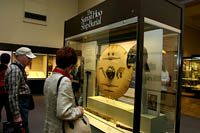 One of my favorite displays is a collection of artifacts from a burial ship found at Sutton Hoo in Suffolk. A king from the early 7 th century was buried in a 30-meter-long (97 feet) ship. They’re not sure which Anglo-Saxon king he was, but he was buried with his sword, shield, helmet, piles of clothes, barrels of food, a great cauldron to cook it in, and an impressive collection of Merovingian coins (from what’s now Belgium) dated from the early 600’s.
One of my favorite displays is a collection of artifacts from a burial ship found at Sutton Hoo in Suffolk. A king from the early 7 th century was buried in a 30-meter-long (97 feet) ship. They’re not sure which Anglo-Saxon king he was, but he was buried with his sword, shield, helmet, piles of clothes, barrels of food, a great cauldron to cook it in, and an impressive collection of Merovingian coins (from what’s now Belgium) dated from the early 600’s.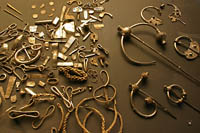 Most of the artifacts from Ireland are from the Viking period around the turn of the first millennium. Most of the Celtic items – brooches, pins and a few statues and pots – are from other parts of Europe.
Most of the artifacts from Ireland are from the Viking period around the turn of the first millennium. Most of the Celtic items – brooches, pins and a few statues and pots – are from other parts of Europe.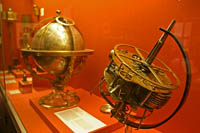 If you follow the numbered floor plan in the British wing, you go from the 7 th century through medieval times to the 19 th century and end up in the Bronze Age. I found that a bit confusing. The room on the development of the clock is kind of fun with some amazingly ornate chronometers.
If you follow the numbered floor plan in the British wing, you go from the 7 th century through medieval times to the 19 th century and end up in the Bronze Age. I found that a bit confusing. The room on the development of the clock is kind of fun with some amazingly ornate chronometers.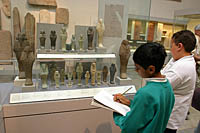 My partner in time gave me the half-hour warning, so I decided I should make a quick visit to Egypt after all. The Egyptian exhibit is on two floors. From Bronze Age Britain, I kept going north through the Ancient Near East to the Ancient Egypt exhibit along the whole north wing of the building. I rushed through the first few rooms of children sketching miniature sarcophagi and headed for the Funerary Archaeology display.
My partner in time gave me the half-hour warning, so I decided I should make a quick visit to Egypt after all. The Egyptian exhibit is on two floors. From Bronze Age Britain, I kept going north through the Ancient Near East to the Ancient Egypt exhibit along the whole north wing of the building. I rushed through the first few rooms of children sketching miniature sarcophagi and headed for the Funerary Archaeology display.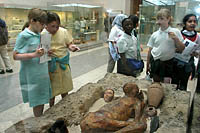 A group of kids was clustered around the reconstructed grave pit of the desiccated body of a Predynastic Egyptian Man. He had the unlikely name of Ginger, and his neighbor, the skeleton, Bones. I glanced at the questionnaire the boy next to me was filling out. “Have the skin and flesh survived?” He checked off Ginger’s box for Yes. Indeed, some hair and fingernails too. Gruesome, but fascinating.
A group of kids was clustered around the reconstructed grave pit of the desiccated body of a Predynastic Egyptian Man. He had the unlikely name of Ginger, and his neighbor, the skeleton, Bones. I glanced at the questionnaire the boy next to me was filling out. “Have the skin and flesh survived?” He checked off Ginger’s box for Yes. Indeed, some hair and fingernails too. Gruesome, but fascinating.